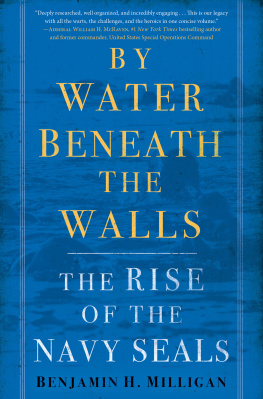
Contents
More Praise for Into Enemy Waters
Anyone awed by the traditions of the US Navy SEALsas everyone should bewill be equally awed by how the SEALs became the SEALs. Dubbins has done a service not only to the SEALs, but also to the armchair adventurer who just wants a rip of a read.
gary kinder , New York Times bestselling author of Ship of Gold in the Deep Blue Sea
A superior piece of narrative military history, offering intimate profiles of the young men called upon to perform some of the most dangerous feats of World War II. Inserted into terrifying battles from Omaha Beach to the Pacific, the Navys first demolition crews conducted a string of astonishing assaults that proved critical to pivotal battles on both fronts. Andrew Dubbins has succeeded in portraying a fully human portrait of these men, who were both vulnerable to the horror of war and somehow able to survive it.
mckay jenkins , author of The Last Ridge: The Epic Story of Americas First Mountain Soldiers and the Assault on Hitlers Europe
Gripping and intensely moving... a timely reminder that war leaves none of its participants unaffected. Andrew Dubbins has honored the memory of those who gave their lives and announced himself as a major new talent in narrative nonfiction.
saul david , author of Crucible of Hell: The Heroism and Tragedy of Okinawa, 1945
A tale of breathtaking and breath-holding daring. This is D-Day and the Pacific Theater as youve never witnessed them beforethrough the eyes of the frogmen who reconnoitered the murky, mine-filled waters and hostile shores for allied landings. Into Enemy Waters reminds us of the meaning of true sacrifice and courage.
buddy levy , award-winning and bestselling author of Labyrinth of Ice: The Triumphant and Tragic Greely Polar Expedition and River of Darkness
A rollicking tale of warfare from a different time, when Americas elite units were cobbled together on short notice and manned with skinny teenagers who had every reason to expect they would get killed in battle. It is a story of noble intentions but also terrible desperation. Andrew Dubbins elegantly weaves personal stories through the grand historical narrative while offering a compelling backstory about the hardscrabble origins of a legendary special operations force.
graeme smith , author of The Dogs Are Eating Them Now: Our War In Afghanistan
As their numbers decline, it is essential to preserve the memories of the veterans of World War II. Andrew Dubbins has done so in this excellent book, describing the tragic horror of that war while writing of the daily acts of courage of those who served. From Normandy to Iwo Jima, his account of the courageous Underwater Demolition Teams, the famed US Navy frogmen, is moving and powerful. But in Dubbinss sensitive telling, it is also so very personal and human. A moving story well told.
james wright , President Emeritus of Dartmouth College, historian, Marine Corps veteran, and author of War and American Life: Reflections on Those Who Serve and Sacrifice


2022 by Andrew Dubbins
All rights reserved. No portion of this book may be reproduced, stored in a retrieval system, or transmitted in any form or by any meanselectronic, mechanical, photocopy, recording, scanning, or otherexcept for brief quotations in critical reviews or articles, without the prior written permission of the publisher.
Diversion Books
A division of Diversion Publishing Corp.
www.diversionbooks.com
First Diversion Books edition, August 2022
Hardcover ISBN: 978-1-635767-72-8
eBook ISBN: 978-1-635767-75-9
Library of Congress cataloging-in-publication data is available on file
Printed in the United States of America
10 9 8 7 6 5 4 3 2 1
To my mother,
Margaret Foster Dubbins,
who encouraged my passion for writing
Contents


Seaman First Class George Morgan climbed down a cargo net draped over the side of a bucking transport ship. Waves crashed into the ships hull, kicking up a cold salt spray that soaked his khaki shirt and dungarees. But Georgea tall seventeen-year -old with the long, smooth muscles of a swimmergripped the splintery rope tightly, continuing downward until at last his boots found the deck of his bobbing landing craft below.
George carried no rifle, only a sheath knife. Hed been trained to use it not as a weapon, but for cutting fuses and detonation cord. He was a member of the US Naval Combat Demolition Units, tasked with blowing up the coastal defenses erected by the Nazis to stymie an Allied invasion.
Peering through the dense fog, George could see the faint outlines of ships. There were hundreds: destroyers, cruisers, transports, tankers, and gigantic, ironclad battleships that rode low in the water. It was June 6, 1944, D-Day . The Allied armada was so vast, it looked as if you could step across the English Channel from ship to ship without getting your feet wet.
Many service members involved in the invasion of Europe would never experience anything like it again. But this was far from the end of Georges war; it was just the beginning. In a few months, his demolition skills would be required in the Pacific, where hed participate in two of the wars bloodiest invasions and land on the very shores of Japan itself, as a member of an elite unit of frogmen that, decades later, would evolve into the Navy SEALs.
After the last member of Georges unit had climbed into the landing craft, it was time for the explosives to be loaded. With sweeping waves rolling the vessel, its coxswain fought to hold her steady and keep her from slamming into the hull of the transport.
As Georges unit was transferring the explosives to the landing craft, a powerful wave pounded into the side of the vessel. The craft lurched violently, and the explosives tumbled overboard, splashing into the water. We lost them , George realized. We lost the explosives!
The coxswain couldnt sit beside the heaving transport any longer and shoved the throttles forward. George was rocked back on his heels as the vessel jolted into motion, its Gray Marine diesel engine vibrating and groaning. The coxswain threw the wheel hard, turning sharply away from the transport. George could hear water rushing against the light plywood hull, as the landing craft straightened and drove eastward through the thick gray fog toward the Normandy coast.
Above the deep-throated roar of the landing crafts engine, George heard what sounded like thunderclaps right over his head. Muzzle flashes twinkled in the fog as the Allied warships began hurling high-caliber shells toward the shoreline. When the landing craft passed near the warships, the demolition men felt a rush of wind from the air displaced by the shells. The draft was so powerful that the men had to fasten their chinstraps to keep their helmets from blowing off.
Above them, the men could see the glowing sixteen-inch shells streaking through the fog like meteors. As the shells slammed into the beach, George heard the low distant rumble of the explosions and saw dim pulses of orange light along the shoreline. An admiral had reassured the demolition men that the barrage would obliterate the German defenses. Not a living soul will be left on that beach, he declared.
Next page















